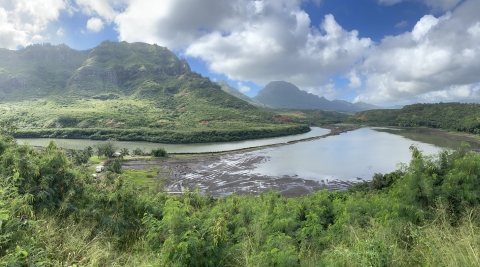Projects and Research
The Hulē‘ia River and surrounding wetlands are being severely overgrown by red mangrove (Rhizophora mangle). This is a species that is native to Florida and Virginia in the USA, but alien and highly invasive in Hawai‘i. The severity of the red mangrove invasion of the Hulē‘ia River cannot be overstated. For more than two miles up the river, both banks are 100% overgrown by red mangrove, mature trees reaching 30 – 40 feet in height. Using Google satellite views, the mangrove trees appear to extend from the open river water inland up to about 450 feet in the worst areas.
A section of the river bordering the Hulē‘ia National Wildlife Refuge (NWR) is under threat of becoming a slow moving swamp. Due to heavy erosion of nearby hills during rainstorms, this part of the river remains brown with silt long after the rain stops. The river cannot quickly flush out the siltage, and the stagnant water between the mangrove roots smells like sewage. The red mangrove thrives here and grows continuously into the open water, anchoring itself into the invaded river space by sending down monster prop roots from high up in the tree, and gradually choking the river. The mangrove jungle is so dense and thick that when paddling past the Hulē‘ia NWR, one never knows that it is there.
The Alekoko fishpond complex adjacent to Hulē‘ia NWR, which once consisted of ponds on both sides of the river, is now reduced to only one main pond that is entirely surrounded by the red mangrove. The main fishpond stone walls are completely buried under the mangrove roots, and circulation of water with the river is practically nonexistent. Again, when viewed from the river, one would never know that the fishpond exists if it were not for one small opening in the mangrove.
We partnered with Malama Hulē‘ia, a non-profit 501c, which has addressed the following:
- Conducted assessments of existing access roads into the refuge, existing roads within the refuge boundaries, and potential new access areas that could be developed that would best protect existing sensitive ecological and cultural resource areas.
- Conducted on-site analysis to determine the best process and alternatives for removing invasive species invasive species
An invasive species is any plant or animal that has spread or been introduced into a new area where they are, or could, cause harm to the environment, economy, or human, animal, or plant health. Their unwelcome presence can destroy ecosystems and cost millions of dollars.
Learn more about invasive species such as: equipment use, staging areas, chipping of materials, use of chipped materials on site, and hauling debris off-site. - Assessed the cultural resources to draft a scope of work for Section 106 compliance.
- Assessed best practices for the project to avoid impacts to the endangered and listed species and their habitat.
- Made recommendations to test sites and procedures for invasive species removal and native plant restoration.



